20 Mediterranean Herbs and Spices (and How to Use Them)
Updated: May 06, 2024

Expand your spice cabinet and your culinary creativity with a flavorful collection of Mediterranean spices.
Whether you love Mediterranean cuisine for the flavors, the health benefits or as part of your heritage, it’s a smart move to stock up your pantry with a variety of Mediterranean spices. They offer an array of sweet, herbal and warm flavors that bring authentic dishes of the region to life. They’ll also perk up any recipe you happen to be making.
Mediterranean herbs and spices such as basil, saffron, rosemary and paprika can be found across the cuisines of the many countries that border the Mediterranean Sea: Italy and Greece; the North African countries of Morocco, Tunisia and Egypt; southern Turkey and Israel; and countries along the Adriatic Sea like Croatia and Albania.
Using the right types of herbs and spices will give you more authentic tasting dishes you’ll love serving to your friends and family. Here’s a list of the most popular ones to get you started.
Aleppo Pepper
Made from dried and ground halaby peppers, Aleppo pepper is produced in Syria and named for the city of Aleppo. The bright red, coarsely ground spice is only mildly spicy, but it’s unique for the fruity flavor that comes from the pepper.
Aleppo is used abundantly in Syria as well as Turkey, and is a popular Middle Eastern spice as well as a Mediterranean one. It’s a key ingredient in the Syrian dip muhammara, which is made with garlic and toasted walnuts. Use Aleppo pepper to flavor everything from stews to roasted meats to vegetable dishes. It also makes Turkish eggs taste extraordinary.
Basil
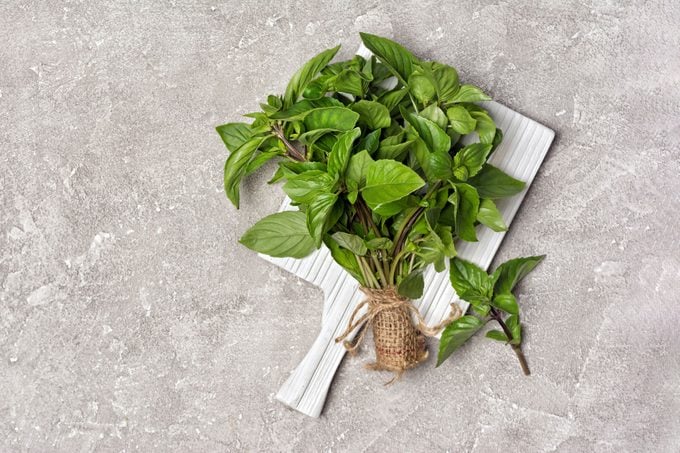
The star of vibrant Italian pesto, basil is one of the most well known of these regional herbs. There are many varieties of basil; the most familiar type is Genovese with large, fragrant, bright green leaves. The flavor of this sweet basil has notes of anise, pepper and mint. Greek basil is a bushier, smaller-leaved type with a flavor that’s more lemony. Purple basil varieties add color and flavor to anything they’re used in. Italian or Mediterranean herb blends often contain dried basil, which has a milder and sweeter flavor than fresh leaves.
Basil is synonymous with Italian cuisine and is also used in dishes throughout the Mediterranean, including Greece, Egypt, Spain and Cyprus. Use fresh basil leaves in dishes like Caprese salad, garlicky bruschetta or a sweet blackberry basil panna cotta.
Bay Leaf
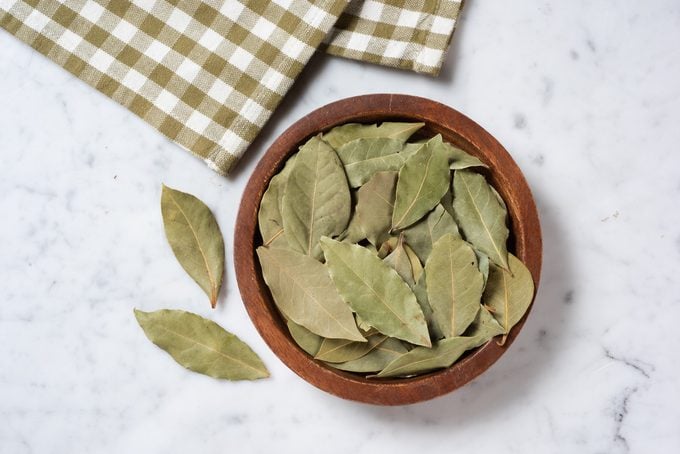
Bay or bay laurel is an herb that has been revered for millennia in the Mediterranean; it’s referenced in ancient literature and was used for crowns in sporting events. Large, flat and grey-green in color, fresh bay leaves have an intriguing, resinous scent, with flavors of eucalyptus and menthol.
When dried (which is how they’re most often used), the flavor mellows and is sweeter, which pairs well with other Mediterranean herbs like oregano, thyme and rosemary. Bay leaves are a popular ingredient in Greece, France, Turkey and Italy. Use dried bay leaves to flavor seafood cioppino, avgolemono soup and to season Spanish rice.
Borage
Borage is one of many edible flowers, and you can eat the leaves of the plant too. The plants, native to the Eastern Mediterranean region, have a sweet, cucumber-like flavor, fuzzy leaves and star-shaped blue or purple flowers—both of which can be used fresh or harvested and dried.
It is part of the Liguria, Italy specialty called preboggion, a fresh herb blend used to flavor risotto. The herb is also a favorite in other parts of Italy and in countries like Turkey and Malta. It’s used to flavor soups, salads, sauces and fillings for pasta.
Cinnamon
Everyone knows all the sweet ways cinnamon flavors treats like cookies, breads and cakes, but in Mediterranean cooking, it creates rich flavor in savory dishes too. Cinnamon isn’t native to the area—it’s grown and harvested in China and Southeast Asia. However, it’s been a part of Mediterranean cuisine for centuries.
Cinnamon has an earthy, warm and spicy flavor and some varieties are especially intense. In Morocco, cinnamon is one of the spices in tagines made with beans, chicken and lamb. A classic Greek tomato sauce like the one used in pastitsio is made with cinnamon, nutmeg and allspice. Turkish recipes add cinnamon to meat and vegetable dishes. The spice also stars in sweet drinks like boza, which is made with fermented rice milk.
Coriander
Dried coriander are the dried seeds from cilantro plants. This can be confusing because in Europe and other parts of the world, coriander is the name of the seeds and the fresh leaves. They’re worth differentiating, though, because the dried seeds have a different flavor—one that’s more mellow, earthy and mildly citrusy.
In the Mediterranean, coriander is found in the cuisines of countries like Greece, Morocco, Algeria and Lebanon; it’s also a part of spice blends like za’atar and garam masala. Use coriander in marinades, soups, stews and other dishes where a longer cooking time helps coax out the flavors. Try it as a seasoning in recipes that love citrus, like a simple skillet salmon.
Cumin
Cumin is a spice with global appeal, and that includes the coastal Mediterranean region. When harvested from the plants, cumin seeds look a lot like caraway seeds, but the flavor is much different. The strong flavor of cumin is earthy and warm, with notes of nuttiness and a slight bitterness. Ground cumin pairs well with ground coriander—like in ras el hanout, a spice blend of Northern Africa.
Use this blend or cumin on its own to add lots of flavor to Moroccan apricot chicken or other meat dishes. The Greek meatball dish soutzoukakia includes a generous dash of cumin. The spice amps up the flavor of vegetable recipes and seafood, and it’s one of the seasonings in shawarma-style sandwiches.
Fennel Seed
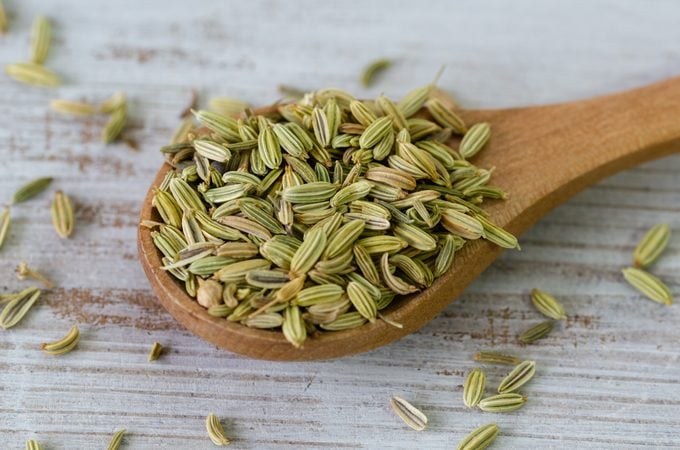
Fennel grows throughout Europe, including the Mediterranean countries of France, Italy and Turkey. The spice has a mild licorice flavor similar to fennel bulb and anise seed.
Fennel seeds can be used whole or ground in breads, spice blends and meat rubs. In Greece and Italy, fennel seed is a key flavoring in sausages made from pork or lamb. Whole fennel seeds can be lightly toasted in a pan to use as a garnish on vegetable sides and soups (like this fennel carrot soup).
Lavender
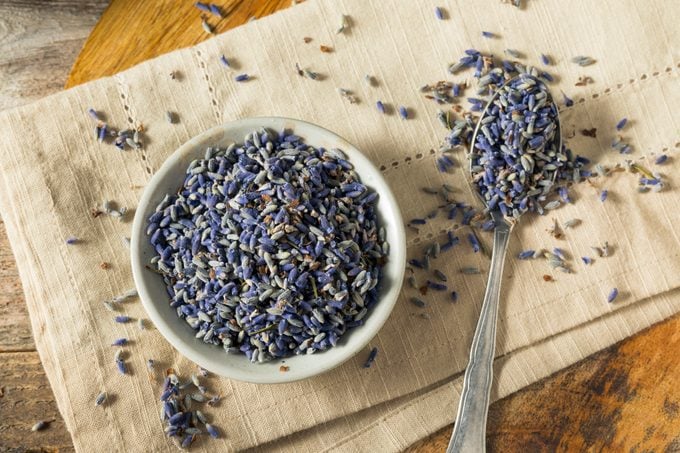
Intensely fragrant and floral, edible lavender buds bring a beautifully perfumed flavor to desserts, baked goods and even savory dishes. The shrubs are native to the Mediterranean, and France is a major producer of the herb. The dried flower buds can be used whole or crushed, and the flavor is so strong that just a little goes a long way.
Lavender can be used in the French spice blend herbes de Provence, but it’s mostly only added in North American versions of the blend. Lavender is also grown in Greece and incorporated into dishes and drinks there. It can infuse olive oil, blend into marinades for meats and flavor cheese as it ages. It pairs well with honey and citrus dishes, such as lemonade and baklava.
Marjoram
Marjoram is another herb native to this warm, coastal region and is related to both oregano and mint. The flavor of marjoram is similar to oregano, but milder and with a resinous, woodsy quality. The plants have tiny leaves and white flowers. The flavor is more intense when the herb is dried, and many cooks prefer dried for that reason.
Marjoram is a staple herb featured in the herbes de Provence blend. It can also be used to flavor the Greek meatball soup called giouvarlakia. Because marjoram pairs so well with other herbs of the region like rosemary, oregano and sage, they’re all often combined into Italian or Greek spice blends for seasoning meats and tomato sauces.
Mint
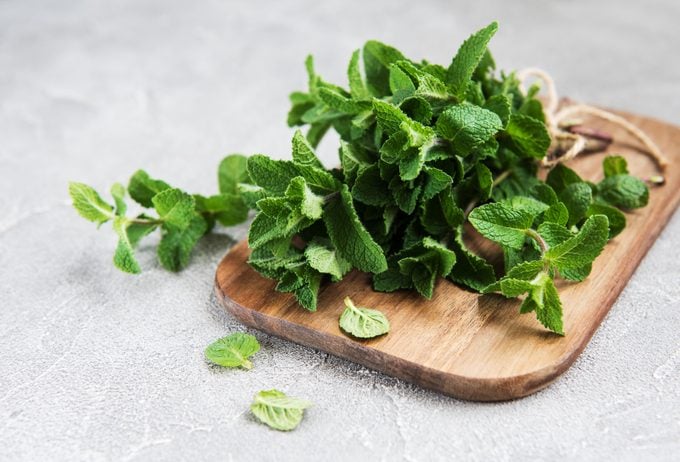
Mint is another spice that has far more potential than just flavoring ice cream and candies. This hardy, perennial herb thrives in the warm climate of the Mediterranean. Mint is known for its cool, crisp effect on the tongue, and depending on the variety there are different intensities and flavors too, such as fruit, spice or chocolate.
Jagged-edged leaves of mint can be used fresh or dried, and it’s a standout herb in many savory dishes in this region. One example is tabbouleh, a cold bulgur wheat salad from the Eastern Mediterranean countries of Syria and Lebanon that’s loaded with chopped mint. Mint tea is a traditional drink of Morocco. Tzatziki sauce, made with yogurt, grated cucumber and mint, is a favorite condiment to serve with Greek gyros. In Malta, mint flavors the traditional fish soup aljotta.
Here’s how to convert fresh to dried herb measurements so you get the right amount into your recipes.
Oregano
This herb is one of the most beloved in Greece; it’s said that Aphrodite herself created oregano as a symbol of happiness. Oregano is part of the mint family of herbs, along with marjoram, lavender and thyme. It grows and spreads as a low ground cover with tiny, fragrant leaves and flowers. Oregano has a sharp aroma and a flavor that can be described as earthy, a little grassy and with subtle hints of mint and pepper.
For lovers of Italian food, it’s instantly recognizable as a main seasoning in spaghetti and pizza sauces. The herb is used everywhere in Greek cuisine from meats to vegetables, cold salads and egg dishes. Oregano is part of North African spice blends, like za’atar, and Turkish cuisine.
Paprika
Made from dried and ground red peppers, paprika has a mild, hot or sweet pepper flavor depending on the variety of pepper used and how much of the heat-packing seeds and ribs are included in the grind. Smoked paprika gets its wood fire flavor when peppers are first smoked before being ground. The spice is a famous product of Hungary, but it’s also produced in Spain and is a favorite seasoning of the Mediterranean region.
Paprika is familiar as a vivid garnish on dishes like deviled eggs, but can be used more boldly to flavor chicken recipes, egg dishes, stews and sauces. Try it in the Lebanese eggplant dip baba ganoush. In Croatia, paprika turns the broth of the fish soup fiš paprikaš a deep red.
Parsley
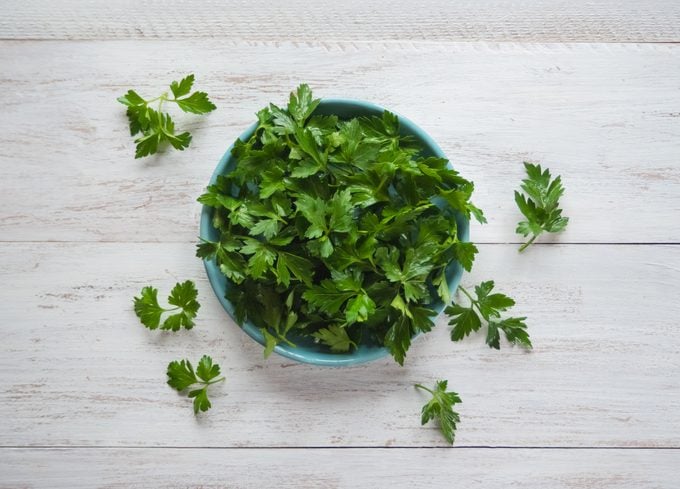
Hardy parsley is a versatile herb used across the Mediterranean region. It’s most flavorful when just-picked but is also very useful as a dried herb. The flavor can be described as clean, fresh and vibrant. Fresh parsley gives dishes a beautiful splash of color.
Lebanese tabbouleh salad has plenty of chopped parsley along with mint, and it’s the preferred garnish for the Italian veal dish osso buco. Parsley also holds up well to heat, and it’s often added to soups and roasted meats or vegetables. The Moroccann condiment chermoula is made by blending parsley into a pesto-like sauce with cumin and paprika.
Rosemary
Yet another member of the mint family, rosemary is the woody herb that looks like little evergreen branches. This perennial, shrubby herb is native to the Mediterranean region, so it’s no surprise that it’s used extensively in the area. Rosemary is very pungent with a resinous, pine-like flavor and notes of camphor and eucalyptus. It can be used fresh or dried.
In Italy, Greece and France, rosemary flavors roasted meats (such as leg of lamb,) vegetables and potatoes. It is often paired with lemon and garlic. In Greece, cooks also like to add rosemary to olive oil for dipping bread. Rosemary is one of the herbs found in bouquet garni and in herbes de Provence blends.
Saffron
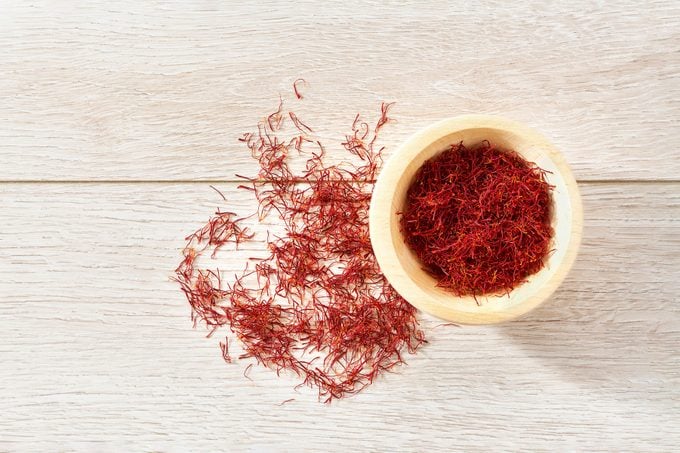
Considered to be the world’s rarest and most expensive spice, saffron is grown in the Middle East, India and the Mediterranean. The strands are the stigmas of a crocus flower that must be painstakingly harvested by hand; at just three stigmas per flower, it takes hundreds of flowers to produce just a gram of saffron.
Despite these challenges, saffron is a key ingredient in Mediterranean cuisine used to season rice and meats. The flavor of saffron is described as musky, earthy and a little bitter. The strands are a bright orange-red and impart a gorgeous golden-yellow hue to the foods cooked with it. In Morocco, saffron is added to slow-cooked tagines, it’s a traditional ingredient in Spanish paella, and Italian cooks season risotto with it.
Sage
With soft, fuzzy, grey-green and highly aromatic leaves, sage is a prized herb in the Mediterranean kitchen; in fact, the plant is native to the region. While sage leaves can be used fresh, it’s more common to find recipes calling for the more strongly-flavored dried versions, either rubbed or ground.
The flavor is earthy, peppery and a little woodsy. In the U.S., sage is a favorite herb at Thanksgiving, but it has year-round appeal in the Mediterranean. In Greece, sage is used in sausages, meat marinades and mushroom dishes. In Italy, sage flavors many dishes including gnocchi and soups. (Try pumpkin gnocchi with sage butter and you’ll know exactly why people fall in love with this herb.) In Albania, sage is used to make soothing, restorative teas.
Sumac
This spice has become familiar to home cooks in the States over the last several years, but sumac has been in use in the Mediterranean since Roman times. Sumac grows as a shrub, where clusters of berries grow on long stems. Once ripened and dried, the berries are ground into a beautiful crimson-red spice that has a tart citrus and fruitlike flavor.
In Lebanon, sumac is used in the bread salad fattoush. In the Palestinian dish musakhan, sumac seasons slow-roasted chicken that’s served on flatbread with onions. It’s also part of the spice blend za’atar. Try sumac in braised meat dishes (like Mediterranean braised chicken thighs) or blended into dips and salad dressings.
Thyme
This ancient herb was so revered in Egypt that the leaves were used when entombing the pharaohs. Today, thyme is used the world over and is a key herb in Mediterranean cuisine. It’s a pretty ground-cover plant with tiny fragrant leaves on delicate stems. Along with oregano and marjoram, thyme is part of the mint plant family.
Thyme has an earthy, peppery and slightly lemony flavor. This herb complements dishes from across the region (try sprinkling it into focaccia dough) and, in its dried form, is part of Italian and Greek spice blends. Thyme is part of the herbes de Provence blend from France and the Middle Eastern blend za’atar.
Za’atar
Za’atar is a blend of spices and herbs—many of which are on this list! (Confusingly, za’atar is also the name of a particular type of wild thyme.) The blend is used throughout the Middle East and also in Mediterranean countries like Syria, Lebanon and Israel. The exact spices used in za’atar vary depending on where it’s created; typically, though, it includes oregano, coriander, marjoram, sumac, thyme, salt and toasted sesame seeds. The flavor is herbal and earthy, along with a tang from the sumac and some crunch from the sesame seeds.
Za’atar can be used to flavor meats and vegetables for cooking (like slow cooker za’atar chicken) but is most often found on tables to be used as a condiment, much like salt and pepper. Serve bread with dishes of oil and za’atar for dipping, blend za’atar into hummus or yogurt sauces, or press it into soft cheeses to serve with crackers or pita chips.




















